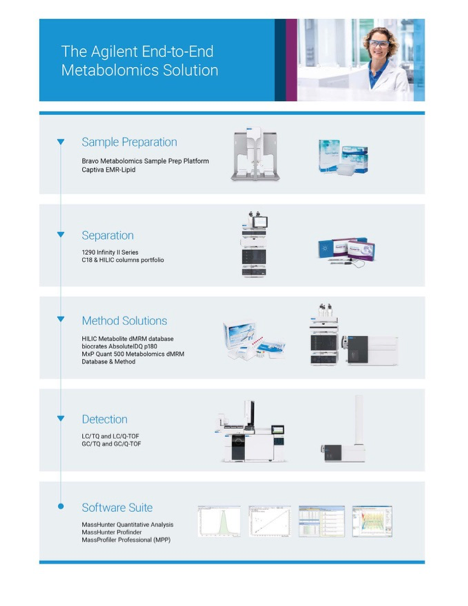Abstract
The metabolome refers to all the small molecules produced by cells or an organism during metabolism. As such, metabolomics data can be used as a direct functional readout of metabolic activity and physiological status. Targeted metabolomics aims to routinely detect and quantify a predefined group of metabolites likely to be involved in biological processes of interest. This application note presents a robust workflow that combines sample preparation and instrumental analysis solutions for targeted metabolomics, and can be applied to plasma and mammalian cell sample types. Automated sample preparation was achieved by combining the Agilent Bravo Metabolomics Sample Prep platform and Agilent Captiva EMR–Lipid plates. Metabolite separation was performed using the Agilent 1290 Infinity II Bio LC ultra-high performance liquid chromatography system coupled with an Agilent InfinityLab Poroshell 120 HILIC-Z column. Metabolite detection were performed using the Agilent 6495 Triple Quadrupole LC/MS system coupled with a custom database of 500 metabolites made using the Agilent MassHunter Optimizer software. The dynamic multiple reaction monitoring (dMRM) method was used with different numbers of ion transitions but can hold one transition for each of the 500 metabolites and can operate reproducibly at a 1 ms dwell time. Additionally, data analysis was performed using the Agilent MassHunter Quantitative Analysis 10 and Mass Profiler Professional (MPP) software. The results presented here demonstrate that this method can be used to efficiently separate metabolites from multiple compound classes in a reproducible way. Moreover, the 6495 Triple Quadrupole LC/MS allows for the detection of metabolites with great sensitivity, even at low dwell times. In summary, this is a reproducible and easy-to-use method that can be customized to fit specific needs and is suited to researchers with varying metabolomics expertise.

Figure 1: Agilent solutions for targeted metabolomics
Introduction
Cells produce, transform, and consume small molecules (< 1500 Da) also known as metabolites; collectively, these are the metabolome. These metabolites are crucial as they reflect an organism’s phenotype. They include molecules that are synthesized during metabolism, such as glucose, cholesterol, ATP, lipids, amine neurotransmitters, amino acids, organic acids, and steroids. 1 Metabolomics research aims to measure these small molecules and find correlations with different physiological states.2 Metabolomics methodologies broadly fall into two categories: untargeted and targeted analyses. Untargeted metabolomics encompasses a comprehensive analysis of all the measurable analytes in a sample, including those which are unknown compounds. In contrast, targeted metabolomics measures defined groups of annotated metabolites.2 As a result, untargeted analysis is typically used for metabolite discovery, while targeted metabolomics is used to provide relative or absolute quantification and validation of specific metabolites of interest.
An end-to-end targeted metabolomics workflow involves sample preparation, separation, detection, and statistical analysis of the metabolites and, thus, requires a combination of different analytical techniques. Agilent offers a full suite Figure 1: Agilent solutions for targeted metabolomics. 3 of hardware, consumables, and software for every step of the workflow (Figure 1). Moreover, all protocols, methods and databases are already packaged and ready for quick implementation in any lab. The workflow presented here combines automated sample preparation, hydrophilic interaction chromatography (HILIC), and triple quadrupole mass spectrometry (LC/TQ) to achieve targeted metabolite detection. As a result, researchers with varying levels of metabolomics expertise can obtain sensitive and reproducible results from various sample types.





